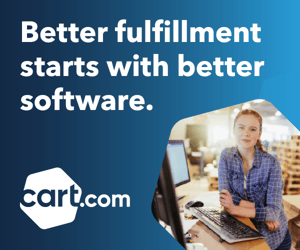Paid ad campaigns have become indispensable for retail brands aiming to capture attention and drive conversions. Whether you're looking to boost brand awareness, generate leads or increase sales, an effective paid ad campaign can make a significant impact, helping your brand gain visibility and reach the right audience. However, creating high-performing ads is no small feat. It requires a blend of strategic planning, creative execution and continuous optimization.
It's essential to follow a few critical steps to craft successful paid ad campaigns. This includes everything from identifying your audience and setting clear objectives to choosing the right platforms and crafting compelling ad copy. It's also about designing eye-catching visuals, utilizing advanced targeting options, optimizing landing pages and monitoring campaign performance. Read on to gain the knowledge and strategies needed to create ads that not only resonate with your audience but also deliver measurable results.
Step 1: Research your audience
Audience research is crucial for creating high-performing paid ad campaigns. Knowing your audience ensures that your message resonates and drives the desired action. Without this foundational step, your campaigns are likely to miss the mark, wasting both time and resources.
To effectively identify and segment your audience, leverage tools like Google Analytics and Facebook Audience Insights, Semrush, BuzzSumo, SparkToro and Audiense. These platforms provide valuable data on user demographics, interests and behaviors. For instance, Google Analytics can reveal which pages on your website attract the most traffic and from which sources, helping you understand what content engages your audience. Facebook Insights, on the other hand, offers detailed information about your followers' age, gender, location and even their online activity patterns.
Creating detailed buyer personas is another essential step. A buyer persona is a semi-fictional representation of your ideal customer based on real data and research. For example, if you sell athletic wear, one of your personas might be "Fitness Fiona," a 30-year-old urban professional who enjoys morning runs and attends yoga classes on weekends. Detailing Fiona’s preferences, challenges and goals helps tailor your ad content to address her specific needs and motivations.
Step 2: Set clear objectives
Setting clear, specific, and measurable objectives is critical for the success of your paid ad campaigns. Without well-defined goals, it’s impossible to gauge effectiveness or ROI. Start by identifying what you want to achieve. Are you looking to boost brand awareness, generate leads or drive conversions? Each objective requires a different approach. For example, if your goal is brand awareness, focus on metrics like impressions and reach. An ad campaign designed to generate leads might track click-through rates (CTR) and form submissions. To drive conversions, you’ll look at the number of completed sales or sign-ups.
Align your ad campaigns with your overarching business goals. If your retail brand is launching a new product, an awareness campaign can create buzz. On the other hand, a conversion-focused campaign with special offers can be more effective if your brand wants to clear out end-of-season inventory. By setting clear goals and objectives, you can tailor your strategies, measure success accurately and make data-driven decisions that align with your business goals, ensuring that your ad spend delivers the best possible returns.
Step 3: Choose the right platforms
Selecting the right platforms for your ad campaigns is essential to reaching your target audience effectively. Each platform offers unique strengths and caters to different demographics, making it important to align your choice with your campaign objectives and audience. Some commonly used platforms include:
- Google Ads: Google Ads is a powerful tool for capturing intent-driven traffic through search ads, display ads and YouTube ads. It's ideal for businesses looking to reach users actively searching for specific products or services. For instance, a home goods retailer might leverage Google Shopping ads to showcase products directly in search results, driving high-intent traffic to their site.
- Facebook Ads and Instagram Ads: Meta platforms are excellent for reaching broad and highly engaged audiences. These platforms excel in visual storytelling, making them perfect for brands with strong visual content. A fashion brand, for example, could use Instagram’s shoppable posts to convert followers into customers seamlessly. Facebook and Instagram Ads work by allowing businesses to create and display targeted advertisements to users on both platforms based on their interests, behaviors and demographics. Advertisers can use a variety of ad formats, such as image, video, carousel and story ads, to engage their audience. These ads are placed in users' feeds, stories and other sections.
- LinkedIn Ads: Ads place on LinkedIn target professionals and businesses and is excellent for B2B marketing. If you’re a company selling business-related products, business services or software, LinkedIn’s precise targeting can help you reach decision-makers in specific industries.
- Bing Ads (now Microsoft Advertising): Microsoft Advertising lets businesses create and display advertisements on the Bing search engine and its partner networks, including Yahoo and AOL. The platform operates on a pay-per-click (PPC) model, where advertisers bid on keywords relevant to their products or services. When users search for those keywords, the ads appear in the search results, and advertisers are charged only when users click on their ads. Microsoft Advertising provides detailed targeting options, including demographics, location, device type, and more, enabling advertisers to reach a highly specific audience. This model helps businesses drive traffic, increase conversions and achieve their marketing goals efficiently.
When choosing a platform, consider your audience demographics, the ad formats available and your budget. For instance, Facebook's extensive targeting options allow you to reach niche audiences, while LinkedIn's higher cost per click (CPC) may be justified by its professional user base. By understanding the strengths and challenges of each platform and how they align with your goals, you can maximize the impact of your ad campaigns and achieve better results.
Step 4: Craft compelling ad copy
Compelling ad copy captures your audience's attention and drives them to act. Effective ad copy should have key elements, including a combination of the following:
- A clear objective
- Creativity and professionalism
- Compelling messaging
- An intriguing offer
- Uniqueness or exclusivity
- Credibility
- Appeal, inspiration or tangible benefits
- Branded tone
- A call to action
- A next step (i.e., a way to respond, a link, etc.).
When writing the text, focus on the benefits of your product rather than just the features. Use persuasive language to highlight how your offering solves a problem or improves the customer’s life. For instance, instead of saying,“Our shoes are made from high-quality materials,” you might say, “Experience ultimate comfort and durability with our high-quality shoes.” A strong CTA is essential for guiding your audience to the next step, whether it’s making a purchase, signing up for a newsletter or visiting your website. Phrases like “Shop Now,” “Get Started,” or “Learn More” can be effective.
A/B testing is a valuable tool for optimizing your ad copy. By creating different versions of your ad and testing them with segments of your audience, you can determine which copy resonates best. This data-driven approach helps you refine your messaging and improve the performance of your campaigns. For example, you might test variations of your headline or different CTAs to see which one generates more clicks or conversions. By focusing on these elements and continually testing and refining your ad copy, you can create more compelling and effective advertisements that drive results for your retail brand.
Step 5: Design eye-catching visuals
Visuals play a large role in the success of your ad campaigns. High-quality images and videos can significantly increase engagement and drive better results. To ensure your visuals stand out, follow best practices such as using high-resolution images, incorporating your brand’s colors and fonts and ensuring the visual elements complement the ad copy. For example, if you're promoting a summer sale, use bright, vibrant colors and imagery that evokes the season.
When designing ad visuals, tools like Canva and Adobe Spark can be incredibly helpful. Canva offers a user-friendly interface with a wide range of templates suitable for various platforms, while Adobe Spark provides advanced editing features for more customized designs. Both tools allow even those with minimal design experience to create professional-quality visuals.
Remember, videos are becoming increasingly important in digital advertising. OptinMonster found that 72% of consumers prefer to learn about a product or a service through video content. Short, engaging videos can capture attention quickly and convey your message more effectively than static images. Consider creating dynamic video content that showcases your products in action or tells a compelling story to connect with your audience.
Step 6: Utilize advanced targeting options
Advanced targeting options allow you to reach the right audience with your ad campaigns. Demographic targeting lets you specify age, gender, income level and more. Geographic targeting focuses on location, whether it’s by country, city or even a specific radius. Behavioral targeting considers users' online behaviors and interests, enabling you to tailor your ads to their preferences.
Retargeting and lookalike audiences are powerful tools in digital marketing. Retargeting focuses on users who have previously interacted with your brand, reminding them of products or services they viewed but didn’t purchase. Lookalike audiences help you reach new potential customers who share characteristics with your existing customers. For instance, if you have a successful customer base in a specific demographic, a lookalike audience can help you find similar prospects.
Refining your targeting based on campaign performance is essential. Use data from your campaigns to understand what’s working and what’s not. For example, if you notice that a particular demographic responds better to your ads, you can adjust your targeting to focus more on that group, maximizing your campaign’s effectiveness.
Step 7: Optimize landing pages
Landing pages boost the success of your ad campaigns, as they are where conversions happen. An optimized landing page can significantly improve your conversion rates. To create high-converting landing pages, ensure they are relevant to the ad, load quickly and have a clear and compelling call-to-action (CTA). Consistency between your ad copy and landing page content is vital; if your ad promises a discount, make sure it's prominently displayed on the landing page.
Best practices for landing pages include using clean, uncluttered designs, clear headlines and persuasive copy. For example, if your ad promotes a new product, the landing page should feature that product with detailed information, customer testimonials and a strong CTA like “Buy Now” or “Learn More.”
Tools like Unbounce and Leadpages can help you create and test landing pages efficiently. These platforms offer templates and A/B testing features to optimize your pages based on user behavior and feedback, ensuring the best possible performance from your ad campaigns.
Step 8: Monitor and analyze performance
Tracking the performance of your ad campaigns allows for continuous improvement. Key metrics to monitor include Click-Through Rate (CTR), conversion rate, Cost Per Acquisition (CPA) and Return on Ad Spend (ROAS). These metrics provide insights into how well your ads are performing and where adjustments may be needed.
Tools like Google Analytics and Facebook Ads Manager offer detailed analytics to help you monitor your campaigns. Google Analytics can track user behavior on your landing pages, while Facebook Ads Manager provides data on how your ads are performing across Facebook’s platforms.
Use the data you gather to make informed decisions and optimize your campaigns. For example, if you notice a high CTR but low conversions, you might need to improve your landing page. Regularly reviewing and adjusting your campaigns based on performance metrics ensures you get the best possible results.
Boost paid ad performance with the help of Cart.com
Applying these strategies can significantly enhance your paid ad campaigns. Whether you choose to implement these steps yourself or seek assistance, the key is to stay informed and adaptable. Cart.com’s marketing services team has the experience to create effective paid ad campaigns, providing valuable expertise and resources. We’ll help you achieve your marketing goals more efficiently. Contact us today to start optimizing your ad campaigns and watch your business grow.
Subscribe to our emails for the latest industry insights!
By entering your email, you agree to receive marketing emails from Cart.com






